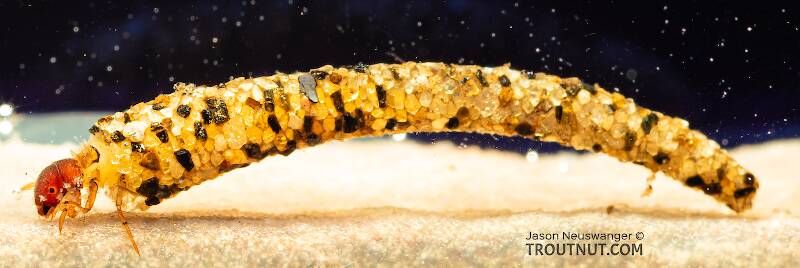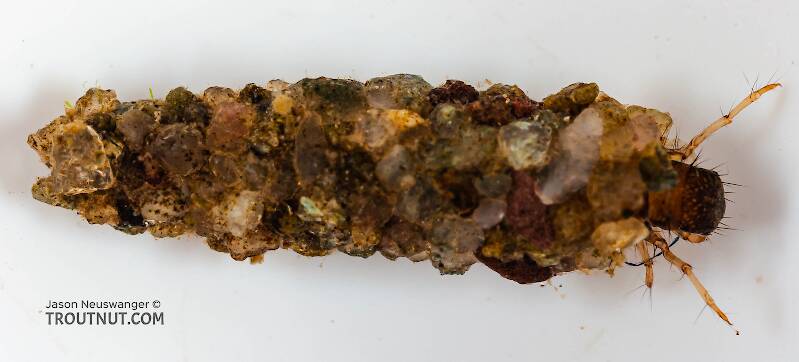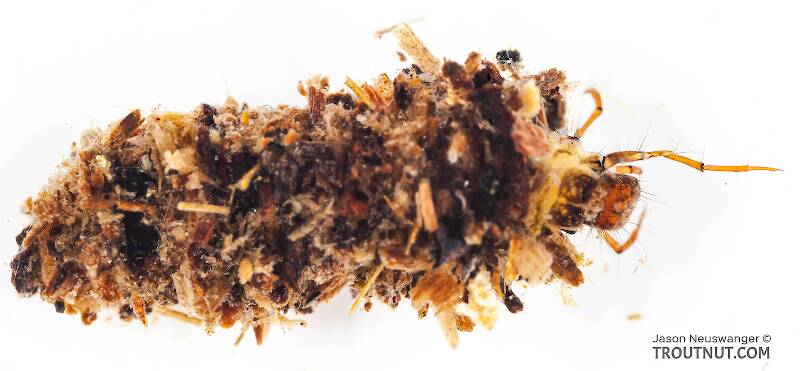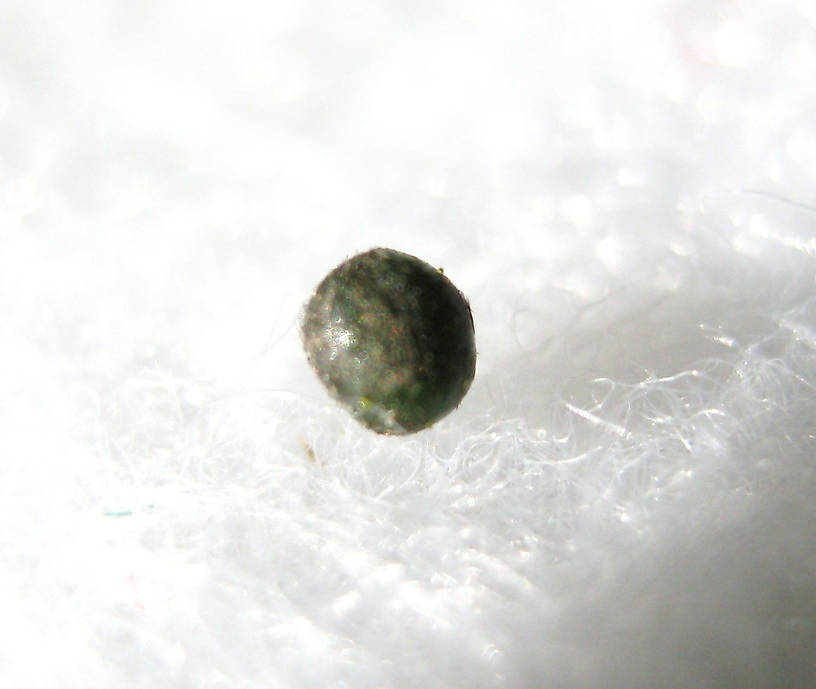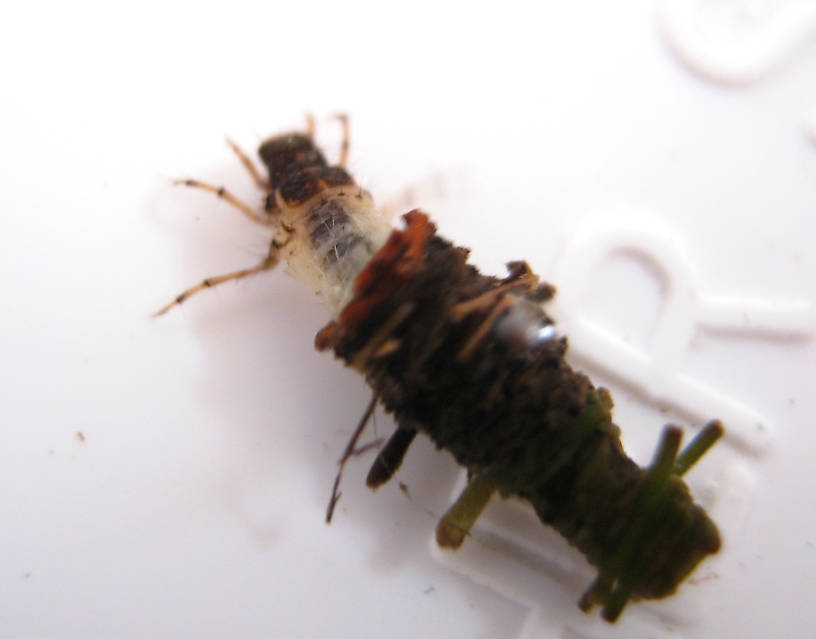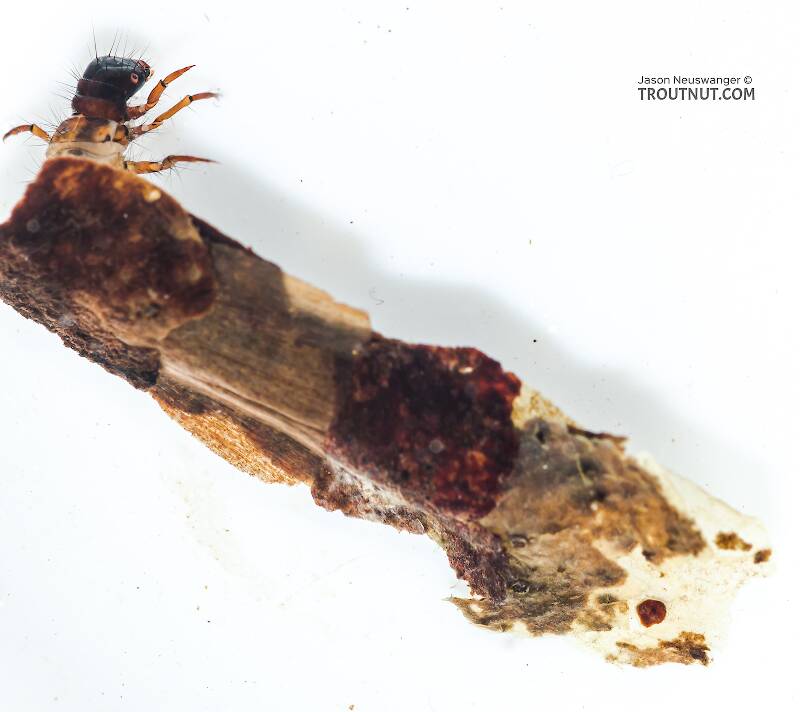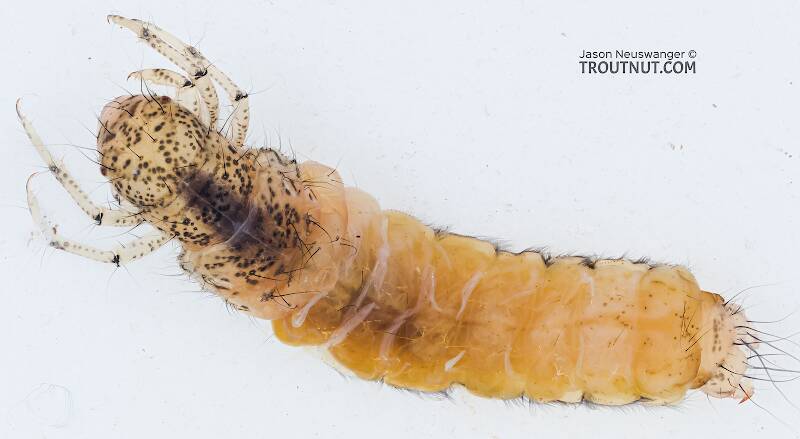
Hex Mayflies
Hexagenia limbata
The famous nocturnal Hex hatch of the Midwest (and a few other lucky locations) stirs to the surface mythically large brown trout that only touch streamers for the rest of the year.
Featured on the forum

Troutnut is a project started in 2003 by salmonid ecologist Jason "Troutnut" Neuswanger to help anglers and
fly tyers unabashedly embrace the entomological side of the sport. Learn more about Troutnut or
support the project for an enhanced experience here.
Identification: Key to Families of Caddisfly Larvae, Couplet 18
Identification: Key to Families of Caddisfly Larvae, Couplet 18
Error: Tried to access a key that isn't live.
Adapted from Merritt R.W., Cummins, K.W., and Berg, M.B. (2019)
This couplet refers figures (usually designated 'sf') from this source.
You will need the source (make sure to get the same edition!) to see them.
This couplet refers figures (usually designated 'sf') from this source.
You will need the source (make sure to get the same edition!) to see them.
| Option 1 | Option 2 |
|---|---|
| Antennae situated on each side near anterior margin of eye (sf 19.107) | Antennae not near anterior margins of eyes, situated approximately as close to anterior margin of head capsule as to eyes (sf 19.89) or closer (sf 19.74) 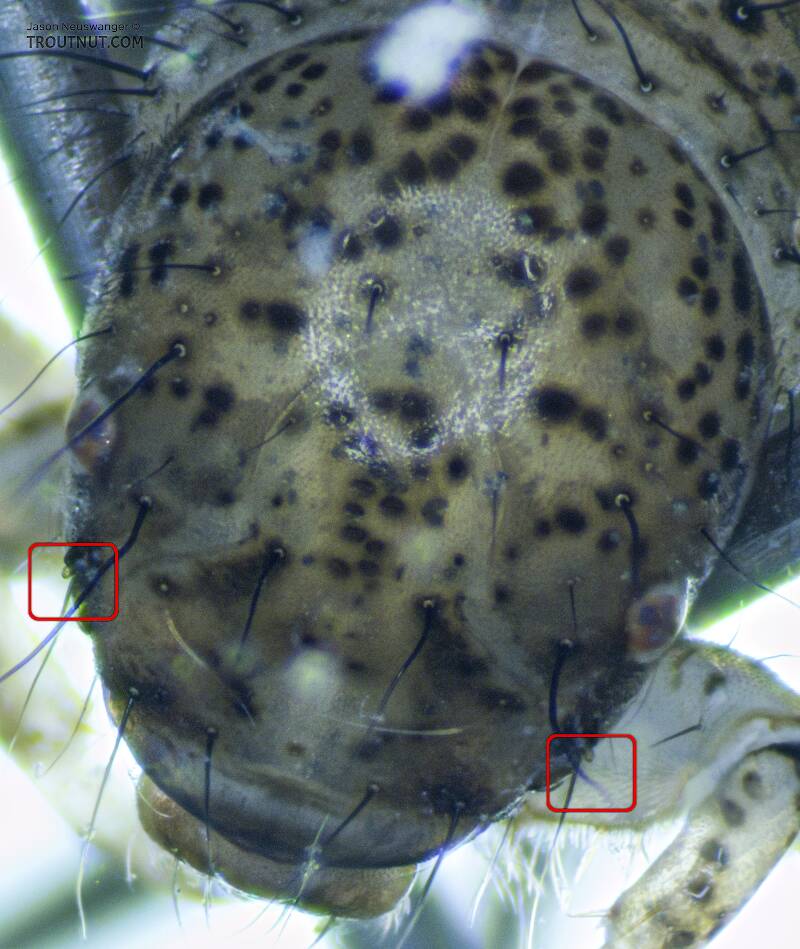
|
| Abdominal segment 1 without median dorsal hump (sf 19.107) | Abdominal segment 1 almost always with median dorsal hump 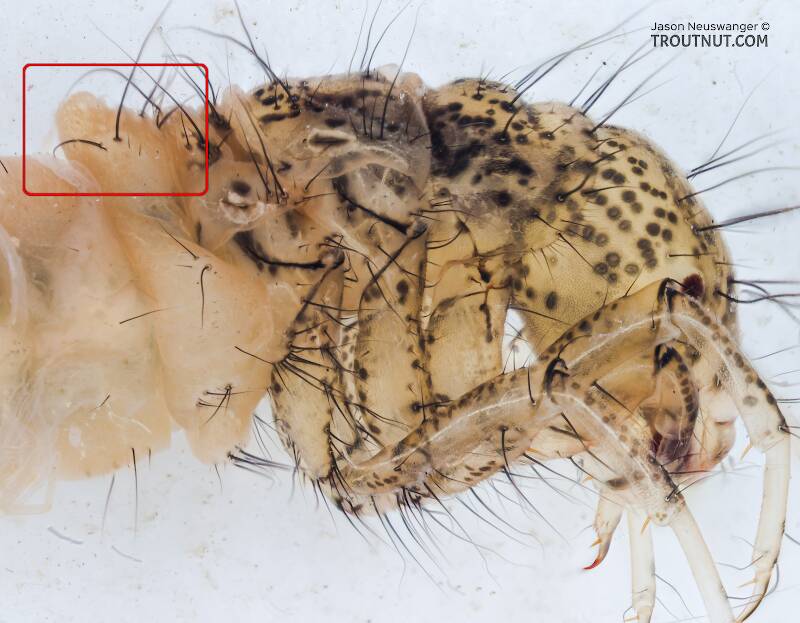
|
| Larvae construct cases of sand (sf 19.21, 19.493) or plant materials (sf 19.20b, 19.20c), with 4-sided cases of plant materials common (sf 19.20a, 19.466) | |
| Remaining families: Apataniidae, Beraeidae, Limnephilidae, Molannidae, Odontoceridae, Rossianidae, Sericostomatidae, Thremmatidae, and Uenoidae | |
5 Example Specimens | 5 Example Specimens |
| Lepidostomatidae | Go to Couplet 19 |
Adapted from Merritt R.W., Cummins, K.W., and Berg, M.B. (2019)
The current couplet is highlighted with darker colors and a icon, and couplets leading to this point have a icon.
Leads to Helicopsychidae:
- Larvae construct portable cases of sand grains or small rock fragments, coiled to resemble snail shells (sf 19.9, 19.178, 19.460a, 19.460b)
- Anal claw comb-shaped (sf 19.113, 19.117)
Leads to Couplet 2:
- Larvae construct portable cases not shaped like coiled snail shells, or they construct no cases at all
- Anal claw with a stout apical hook
Couplet 2
Leads to Couplet 3:
- Metanotum entirely covered by pair of sclerites (sf 19.62, 19.63)
Couplet 3
Leads to Couplet 5:
- Metanotum entirely membraneous (sf 19.71), or largely so but with several pairs of smaller sclerites (sf 19.90)
Couplet 5
Leads to Hydropsychidae:
- Abdomen with ventrolateral rows of branched gills
- Prominent tuft of long setae at base of anal proleg
- Larvae construct fixed retreats of detritus and rock fragments rather than portable cases (sf 19.34, 19.35)
- Very widespread and abundant trout stream caddisfly family, with a variety of sizes, very often exceeding 5 mm in body length
Leads to Couplet 4:
- Abdomen without branched gills
- No prominent tuft of setae at the base of the anal proleg
- Larvae construct various fixed retreats or portable cases
- The only widespread family beyond this couplet is typically less than 5 mm long
Couplet 4
Leads to Ecnomidae
(Austrotinodes texensis):
(Austrotinodes texensis):
- Anal claw large and at least as long as its sclerotized basal segment, with anal proleg projecting freely from abdomen (sf 19.70)
- Body length typically greater than 5 mm
- Larvae construct fixed tubular retreats of sand (sf 13.96)
- Limited in North America to Texas
Ecnomidae
(Austrotinodes texensis)
(Austrotinodes texensis)
Leads to Hydroptilidae:
- Anal claw relatively small, anal proleg usually not projecting freely from abdomen (sf 19.62, 19.234), sometimes projecting freely (sf 19.233, 19.235)
- Body length typically less than 5 mm
- Larvae construct purse-shaped portable cases of silk (many source figs), sometimes with sand (sf 19.39) or plant material (many source figs), or flat silken domes fastened to rocks (sf 19.40, 19.241), or cylindrical cases covered with tiny sand grains (sf 19.43, 19.242)
- Widespread
Leads to Leptoceridae:
- Antennae usually relatively elongate and prominent, at least 6 times as long as wide (sf 19.96)
- If antennae not as above (and often when they are), sclerotized plates on mesonotum are lightly pigmented except for pair of dark curved lines on posterior half (sf 19.97)
- Larvae construct portable cases of various materials (many source figs)
Leads to Couplet 6:
- Antennae of normal length, not more than 3 times as long as wide (sf 19.107) or not apparent at all (sf 19.67)
- Mesonotum never with pair of dark curved lines as at left
Couplet 6
Leads to Couplet 7:
- Mesonotum largely or entirely membraneous (sf 19.71), or with small sclerites covering not more than half of the notum (sf 19.77)
- Pronotum never with anterolateral lobe (sf 19.76)
Couplet 7
Leads to Couplet 15:
- Mesonotum largely covered by sclerotized plates, variously subdivided (sf 19.102-104, 19.88), and typically pigmented, although sometimes lightly (sf 19.112)
- Pronotum sometimes with prominent anterolateral lobe (sf 19.111, 19.112)
Couplet 15
Leads to Couplet 8:
- Abdominal tergum 9 with sclerite, sometimes pale and inconspicuous or obscured by posterior margin of abdominal tergum 8 (sf 19.59, 19.60)
Couplet 8
Leads to Couplet 11:
- Abdominal tergum 9 entirely membraneous (sf 19.73)
Couplet 11
Leads to Phryganeidae:
- Metanotal sa3 typically consisting of cluster of setae arising from small rounded or ovoid sclerite (sf 19.77, 19.372-19.374)
- Prosternal horn present (sf 19.70, 19.368)
- Larvae construct tubular portable cases, typically of plant materials (many source figs)
Leads to Couplet 9:
- Metanotal sa3 consisting of a single seta with or without sclerite (sf 19.61)
- Prosternal horn absent
- Larvae either without portable tubular cases, or with tortoise-like domed cases of rock fragments (sf 19.38)
Couplet 9
Leads to Glossosomatidae:
- Anal prolegs each with basal half broadly joined with segment 9, its anal claw with at least one dorsal accessory hook (sf 19.59, 19.60)
- Larvae construct tortoise-like domed portable cases of rock fragments (sf 19.38, 19.167, more)
Leads to Couplet 10:
- Anal prolegs mostly free from segment 9, its anal claw without dorsal accessory hook, although secondary lateral claw may be present (sf 19.57)
- Larvae free-living, without cases or fixed retreats until pupation
Couplet 10
Leads to Hydrobiosidae
(Atopsyche):
(Atopsyche):
- Tibia, tarsus, and claw of each foreleg shortened, articulated against extended lobe of femur to form chelate appendage (sf 19.58)
- Southwest distribution
Hydrobiosidae
(Atopsyche)
(Atopsyche)
Leads to Rhyacophilidae:
- Foreleg normal, not modified as chelate appendage (sf 19.57)
Leads to Philopotamidae:
- Labrum membraneous and T-shaped (sf 19.71), often withdrawn from view in preserved specimens
- Larvae construct fixed sac-shaped nets of silk (sf 19.32)
Leads to Couplet 12:
- Labrum sclerotized, rounded, articulated in normal way and never withdrawn (sf 19.67)
Couplet 12
Leads to Xiphocentronidae:
- Mesopleuron extended anteriorly on each side as a lobate process (sf 19.69)
- Tibiae and tarsi of all legs fused together (sf 19.69)
- Larvae construct fixed, meandering tubes of sand on rocks
- Distributed in Arizona and Texas
Xiphocentronidae
Leads to Couplet 13:
- Mesopleura unmodified
- Tibiae and tarsi separate on all legs (sf 19.65)
Couplet 13
Leads to Psychomyiidae:
- Foretrochantins each extended as broadened, hatchet-shaped lobe best seen from ventrolateral direction (sf 19.64)
- Larvae construct fixed tubular retreats of sand and debris on rocks and logs (sf 19.36)
Leads to Couplet 14:
- Foretrochantins each with apex acute, not expanded into broadened lobe
Couplet 14
Leads to Dipseudopsidae:
- Tibiae of all legs markedly flattened, with tibiae shorter than tarsi (sf 19.68)
- Larvae construct tubes of sand and silk, buried in usually soft sediments (sf 19.33)
Dipseudopsidae
Leads to Polycentropodidae:
- Tarsi of all legs more or less cylindrical and not flattened, with tibiae as long as or longer than tarsi (sf 19.65)
- Larvae construct exposed funnel-shaped or tubular nets of silk (sf 19.37) or flattened retreats
Leads to Brachycentridae:
- Abdominal segment 1 lacking both dorsal and lateral humps (sf 19.102)
- Metanotal sa1 absent (sf 19.103) or represented by only a single seta without sclerite
- Larvae construct portable cases of silk and usually sand and/or transversely arranged plant materials that are either cylindrical or 4-sided (many source figs)
Leads to Couplet 16:
- Abdominal segment 1 always with lateral humps although not always prominent, usually with median dorsal hump (sf 19.76, 19.86)
- Metanotal sa1 always present, typically represented by sclerite bearing several setae (sf 19.81) but with at least a single seta
- Larvae construct portable cases of widely differing form and materials
Couplet 16
Leads to Goeridae:
- Mesopleura extend anteriorly on each side as prominent, acutely or bluntly pointed process (sf 19.105, 19.106)
- Larvae construct cases of rock fragments (many source figs)
- Distribution east, midwest, northwest
Leads to Couplet 17:
- Mesopleura not extended anteriorly as pointed processes (e.g., sf 19.88, 19.95)
Couplet 17
Leads to Calamoceratidae:
- Labrum with transverse row of approximately 16 setae across central area (sf 19.95)
- Larvae construct cases of wood and other plant materials variously arranged (many source figs)
- Distribution east, southeast, southwest, west coast
Calamoceratidae
Leads to Couplet 18:
- Labrum typically with only 6 setae across central area
Couplet 18
Couplet 18 (You are here)
Leads to Lepidostomatidae:
- Antennae situated on each side near anterior margin of eye (sf 19.107)
- Abdominal segment 1 without median dorsal hump (sf 19.107)
- Larvae construct cases of sand (sf 19.21, 19.493) or plant materials (sf 19.20b, 19.20c), with 4-sided cases of plant materials common (sf 19.20a, 19.466)
Leads to Couplet 19:
- Antennae not near anterior margins of eyes, situated approximately as close to anterior margin of head capsule as to eyes (sf 19.89) or closer (sf 19.74)
- Abdominal segment 1 almost always with median dorsal hump
Couplet 19
Leads to Couplet 20:
- Antennae situated approximately midway between anterior margin of head capsule and eyes
- Prosternal horn typically present, although sometimes short
- Chloride epithelia typically present on at least some abdominal segments
Couplet 20
Leads to Couplet 24:
- Antennae situated at or near anterior margin of head capsule (sf 19.74)
- Prosternal horn absent (sf 19.72)
- Chloride epithelia absent (sf 19.72)
Couplet 24
Leads to Couplet 21:
- Mesonotum notched anteromedially (sf 19.85, 19.421, 19.422, 19.425-19.427)
Couplet 21
Leads to Couplet 22:
- Mesonotum not notched anteromedially, although its anterior edge may appear broadly concave in a dorsal view
Couplet 22
Leads to Uenoidae:
- Larvae very slender
- Larvae without gills
- Pronotum broadest anteriorly in dorsal view and anteromedial notch of mesonotum deep (sf 19.425-19.427)
- Constructing slender cases of silk (sf 19.456) or sand and silk (sf 19.28, 19.487, 19.488)
- Western distribution
Leads to Thremmatidae:
- Larvae not slender
- Larvae with gills
- Pronotum broadest about middle in dorsal view and anteromedial notch of mesonotum shallow (sf 19.85, 19.421, 19.422)
- Constructing stouter cases of rock fragments, often with small stones arranged linearly along each side (sf 19.27, 19.484)
Leads to Apataniidae:
- Mandibles each usually with uniform scraper blade (sf 19.83)
- If mandible toothed instead (sf 19.82), then more than 25 setae present on membraneous area of metanotum between the left and right metanotal sa1 sclerites (sf 19.81)
- Metanotal sa1 sclerites absent in some genera. Larvae construct cases mainly of mineral materials (sf 19.126, 19.429, 19.430, 19.481, 19.502) Distributed in Appalachian Mountains, North, and West
Leads to Couplet 23:
- Mandibles almost always toothed (sf 19.49)
- Setae typically absent from area between metanotal sa1 sclerites If setae present in this location, these setae number fewer than 25
Couplet 23
Leads to Limnephilidae:
- Mesonotum with one large sclerite on each side of midline
- Chloride epithelia typically present on at least some abdominal segments
- Larvae construct cases of plant (many source fig) or mineral materials (many source figs), or a combination of the two (many source figs), occasionally with mollusk shells (sf 19.442b)
Leads to Rossianidae:
- Mesonotum with 2 (sf 19.94) or 3 (sf 19.93) smaller sclerites on each side of midline
- Chloride epithelia absent (sf 19.92)
- Larvae construct cases almost entirely of rock fragments (sf 19.26, 19.411, 19.455, 19.464)
- Northwest distribution
Rossianidae
Leads to Molannidae:
- Tarsal claw of each hind leg modified to form short stub or slender filament (sf 19.98, 19.100)
- Larvae construct cases of sand grains with flanges on sides and overhanging anterior opening (sf 19.6, 19.457, 19.458)
- Distribution central, east, far northwest
Leads to Couplet 25:
- Tarsal claws of hind legs not different in structure from those of other legs (sf 19.72)
Couplet 25
Leads to Beraeidae:
- Pronotum with transverse carina or ridge extended into rounded anterolateral lobe on each side (sf 19.111, 19.112)
- Larvae construct cases of sand grains (sf 19.8,19.489)
- Eastern distribution (highly localized)
Beraeidae
Leads to Couplet 26:
- Pronotum without transverse carina, and anterolateral corners not lobate, although pointed in some genera (sf 19.109)
Couplet 26
Leads to Sericostomatidae:
- Dorsum of each anal proleg with cluster of approximately 30 or more setae mesal of lateral sclerite (sf 19.73)
- Lateral sclerite of each anal proleg relatively small in dorsal view (sf 19.73)
- Foretrochantins relatively large and hook-shaped apically (sf 19.75)
- Larvae construct cases mainly of fine rock fragments (many source figs)
Sericostomatidae
Leads to Odontoceridae:
- Dorsum of each anal proleg with no more than 3-5 setae mesal of lateral sclerite, although with short spines in some genera
- Lateral sclerite of each anal proleg relatively large (sf 19.110)
- Foretrochantins smaller than at left and not hooked apically (sf 19.108)
- Larvae construct cases of rock fragments (many source figs)
Start a Discussion of this Couplet
References
- Merritt R.W., Cummins, K.W., and Berg, M.B. 2019. An Introduction to the Aquatic Insects of North America (Fifth Edition). Kendall/Hunt Publishing Company.



